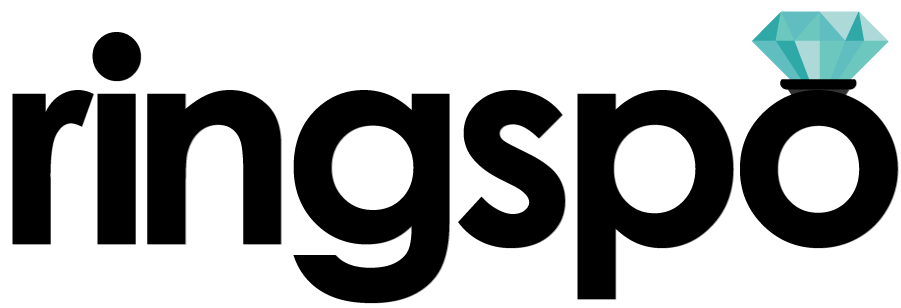Gold engagement rings
Traditional beauty with yellow gold
Ringspo is reader supported
Ringspo is reader-supported, which means we may receive a commission if you click a link to a retailer & subsequently make a purchase.
We feature links to several retailers to help readers find the one that is the best fit for them. Find out more about how Ringspo works here.
Prized by the ancient Egyptians, the Aztecs, Romans and the dragon out of Shrek, gold’s rarity and sparkle means that it has always been valued far above its actual usefulness as a metal.
Today its warm tones and sense of luxury means that it’s still the most popular precious metal in the world, even if it has been overtaken by white gold for engagement rings.
We’re going to look at:
- A bit of technical info about yellow gold engagement rings (I’ll keep it brief, I promise)
- What’s good about yellow gold engagement rings
- What’s not so good
- A selection of rings to check out
At the end of this page, you should have everything you need to know to get an awesome gold engagement ring at a great price.
Not sure which metal color to get?
If you’re a guy and you’re not sure whether to get a yellow gold or a white-colored engagement ring, the easiest way to tell is to check out your better half’s jewelry box.
If the majority of the jewelry is yellow gold, then stick with it. But, if the majority of her jewelry is silver or white gold, then consider white gold or platinum for your ring.
Yellow gold is still the most common and popular type of gold used throughout the world, in part because it’s the closest form to gold’s natural stare.
But the gold used in jewelry is almost never ‘pure’ 24 karat gold. Pure gold is way too soft to be used in jewelry that is going to be worn all the time and asked to survive day-to-day knocks and drunken nights out on the tiles.
So gold is mixed with other metals to form stronger alloys, with the proportion of actual gold to other metals indicated by the ‘karat’ system.
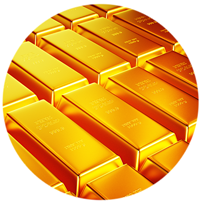
100% pure gold has 24 parts out of 24 made out of gold. The other karat grades that are traditionally used in jewelry are:
- 9 karat = 9/24 = 38% pure gold
- 10 karat = 10/24 = 42% pure gold
- 14 karat = 14/24 = 58% pure gold
- 18 karat = 18/24 = 75% pure gold
- 24 karat = 24/ 24 = 100% gold
The different amounts of gold give each of the karat ratings slightly different properties because of the natural properties of the metals contained in the alloy.
18 karat yellow gold rings are 75% pure gold – a typical mixture for 18kt gold might be 75% Gold, 12.5% Silver, and 12.5% Copper.
18 karat gold rings have warmer and brighter glow than rings with lower percentages of gold and they’re also more likely to last longer: the higher level of gold means that they are less likely to tarnish. But the increase in the amount of gold also results in a higher price. How much higher depends on the ring setting style and the amount of gold used.

14 karat gold rings contain nearly 60% gold, with the rest made up of copper, silver and sometimes zinc. Although they do still have a warm yellow hue, it’s not quite as bright or luminous as an 18 karat gold ring.
9k and 10 karat gold engagement rings contain only around 40% gold, so a much higher percentage of other metals. As a result these rings usually have either a whiter or a more copper-like color than rings with a higher karat rating, are more brittle and are the most likely to tarnish. But, the payoff is that they are considerably more affordable than rings with a higher gold content.
What’s good about gold engagement rings?
Effect on diamond color
One of the most budget-friendly advantages of choosing a yellow gold setting for your engagement ring is the money that you can save on the color of your diamond.
Diamond color is a continuous scale from white at the top (most expensive) to yellow at the bottom (least expensive).
White ring settings, like white gold or platinum, need to be paired with a very white diamond, or the diamond will look yellower than it really is. This is because the stone is yellower than the very white metal, and being put right next to something that is whiter than it makes the diamond look less white itself.

With yellow gold settings though, most diamonds will be much, much whiter than the ring setting, even if they are quite far down the color scale.
This means that you can choose a ‘warmer’ color and it will still look white, even if it does actually have yellow tints.

The savings that can be made by choosing a lower color grade can be significant. To demonstrate just what a difference dropping a few color grades can make on the price of a diamond, I looked at two diamonds on one of my recommended retailers and changed just the color. I look at one diamond with color G, which is the color I recomend for white-colored ring settings, and one with color K, which is a safe color to choose for a gold setting, without the stone appearing yellow at all.
The diamond stats that I searched for were:
- Carat: 1
- Clarity: VS1
- Cut: Excellent
You can see the results below:
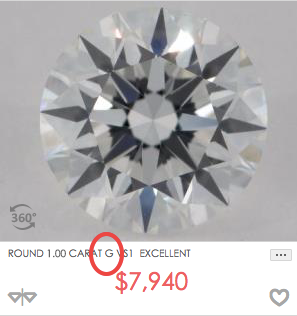

That’s an absolutely huge difference – nearly a 50% discount for something which will not make a visible difference to the quality of your engagement ring once it is set in a yellow gold setting. This means that you can put more of your budget towards a larger rock, or one with a higher clarity grade, or just towards an awesome honeymoon.
What’s not so good about yellow gold engagement rings?
Effect of diamond color
The big advantage that we discovered in the last section can also be a bit of a disadvantage.
While the yellow color of gold engagement rings does a great job of making warmer colored diamonds look whiter, it actually has the exact opposite effect on diamonds that are very white to start with. Very white diamonds will reflect the yellow color from a gold setting, making even a rare and pricy D or E color diamond look much warmer and yellower than it really is.
The solution if you want to go for a very white diamond is to choose a ring setting with a yellow gold band and a white gold

Allergy
Lastly, some people (around 10%) are allergic to gold, which makes it uncomfortable to wear.
Actually, people aren’t allergic to gold, they’re allergic to nickel which is sometimes used in gold alloys. It’s something to be mindful of, but if you’re buying for a special someone and they already wear gold jewelry, then it’s a safe bet that they can wear gold safely.
Yellow gold engagement ring settings
While it’s important to get the best center stone that you can for you ring, it’s the ring setting that really defines the character of the ring.
This list below is by no means definitive, but it’s a representation of some of the different styles of gold engagement ring settings that are available. If you see a setting you like, click through to find out more and check out the other gold setting styles that each jeweler offers too.
The classic solitaire is the best selling engagement ring by far, year after year. Its combination of elegant design and low cost due to simplicity is hard to beat.
Pictured are the traditional 4 prong setting and the ‘Tiffany-style’ 6 prong setting. Both of these rings have paired a yellow gold band with a white gold basket, which makes them suitable for a high quality white stone. Click through to find out more.
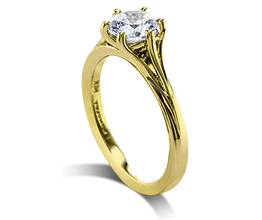
Elegant prong settings don’t need to be so straightforward though. A slight twist on the design can result in an interesting and unique look, while retaining the simplicity and elegance that makes gold solitaire engagement rings so popular.
Split Shank 6 prong engagement ring from Brian Gavin
Check out all engagement rings from Brian Gavin
The number of variations on the solitaire setting are nearly endless, as this twisted ‘cable’ engagement ring shows. Small tweaks like this can make an engagement ring much more individual and personal.
Twisted shank gold engagement ring from James Allen
Check out all yellow gold ring settings from James Allen

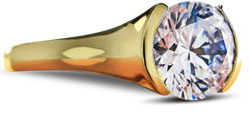
Bezel settings can be a great choice for those with active lifestyles who benefit from the protection that the bezel provides to the edge of a diamond. However, full bezel settings can limit the amount of light that enters a diamond, meaning that they sparkle less than they should.
This ‘half bezel’ yellow gold engagement ring has the benefit of protecting the majority of the diamond, while still allowing a large amount of light to enter the sides of the stone.
Taking inspiration from the past, vintage-style gold engagement rings can bring a completely different flavour. This example uses a highly sculpted band to highlight the gold color through the differences in light and shadow.
Vintage-style sculpted solitaire engagement ring from James Allen

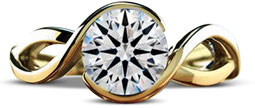
Other variations on the ring band design can also make a ring more interesting and individual. This example pairs a ‘criss cross’ ring band design with a half bezel setting, providing a great combo of design and security for the diamond.
Criss-cross engagement ring from Brian Gavin
Check out all gold settings from Brian Gavin
Adding supporting diamonds to the ring band can be a great way of ensuring that the center stone doesn’t need to do all of the impressing on its own.
This gold pavé solitiare engagement ring has a full half a carat of diamonds on the band, adding considerable extra bling for a much, much lower cost than increasing the center stone by 0.5 carat would.
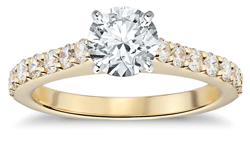

Many of the styles on this page can be combined, like this criss cross ‘bypass’ pavé ring from designer ring maker Verragio.
Pavé engagement rings like this often have diamonds on the band only half way round to ensure that they are seen where it counts, and also to ensure that the ring is easy to resize.
Pavé bypass setting from Whiteflash
Check out all Whiteflash engagement ring settings
There’s a huge number of varaitions of pavé engagement ring settings – this example has 38 small diamonds of the highest ‘hearts and arrows’ quality set into the V-shaped ‘shank’ of the ring band. With such a high number of top quality stones in the band, the ring will provide incredible sparkle from any angle.
V-Shank pavé engagement ring from Whiteflash
Check out all Whiteflash engagement ring settings


Halo settings are a great way to increase the impressiveness of any ring. This ring uses a cushion cut stone, which are usually priced considerably lower than round diamonds, and supports it with a angular halo for a striking effect.
There are a huge number of variations on the halo setting, with the almost endless number of combinations of diamond shape and halo shape. This hexagonal halo harks back to the straight edges and geometric designs of the Art Deco era.

